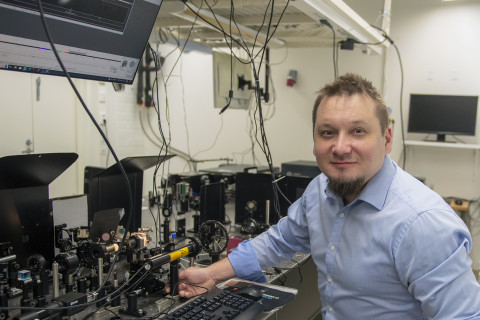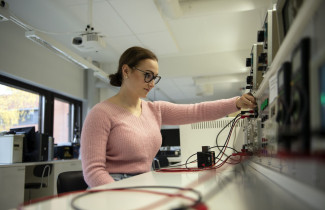According to Professor Tommi Hakala, nanophotonics is a field of science that aims at smaller optical devices and diverse harnessing of light for technology.
Future applications of nanophotonics are endless
“The size of electronic components used in computers has been shrinking for a long time. Processors are getting larger in size, but we are nevertheless starting to meet the limits of individual transistors in terms of their speed and size. Photonic computing will be very fast compared to what we have today,” Hakala says.
“Optical elements, such as lenses and objectives, are typically large elements that are difficult to shrink. In nano-optics, however, they can be miniaturised.”
For the time being, research is carried out at the level of basic technology, but the next ten years will witness major development.
“Completely flat lenses, for example, would have a great variety of applications, since they could be installed in any device,” Hakala says.
Nano-lasers for sensor technology
After graduation, Hakala worked as a postdoc at Harvard University in Boston, where he studied, e.g., Bose-Einstein condensates (BECs) in atomic clouds.
“BEC is kind of like the fifth state of matter, in which a condensate contains a large number of atoms at the lowest possible energy state of a system. This forms a coherent state in which atoms act as if they were a single particle.”
His research continued at Aalto University, where the BEC phenomenon could be realized in nanoscale lattice samples at room temperature. Normally, the phenomenon can only be studied at low temperatures.
Hakala was brought to the University of Eastern Finland by an interesting professorship, state-of-the-art clean room facilities, and just the right setting of optics for research.
At the moment, he is particularly interested in developing nano-scale lasers.
“Such lasers could be used, for example, in sensor technology and in fully optical data processing. Once we move past basic technology, new applications will appear on the horizon. After all, lasers, too, were first used in scanners,” Hakala points out.
“I also study how the polarisation of light and the formation of laser beams can be controlled in the nano-scale. Multimode lasing, on the other hand, refers to multi-wavelength and multi-colour lasing, which can produce white laser light, among other things.”
More important, according to Hakala, would be mode locking of different wavelengths, which could enable the generation of femtosecond laser pulses in nano-scale samples.
“This has previously been achieved with devices of approximately one square metre in size. Our objective is to develop a device that is 100 million times smaller, i.e., 100 x 100 micrometres in size.”
Originally from the Jämsä region in Central Finland, Hakala enjoys working with his colleagues on the Joensuu Campus. He spends his leisure time fishing and exercising, and he plays the sax and the guitar. His other hobbies include painting and playing pool billiards.
TOMMI HAKALA
- Professor of Experimental Nanophotonics, University of Eastern Finland, 1 August 2022–
- PhD (physics), University of Jyväskylä, 2009
KEY ROLES
- Associate Professor (Tenure Track), University of Eastern Finland, 2018–2022
- Postdoctoral Researcher, Harvard University, 2010–2013
- Postdoctoral Researcher & Staff Scientist, Aalto University
- Expert in nanofabrication methods and nano-optics




